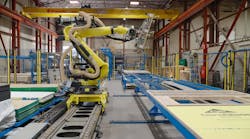The need to increase energy efficiency and savings while implementing green and sustainable measures, coupled with legislation such as the Energy Policy Act of 2005 and the Energy Independence and Security Act of 2007, which imposes certain energy-efficiency standards on buildings, is driving strong growth in the building-automation-systems (BAS) market.
New analysis from Frost & Sullivan's Analysis of the North American Building Automation Systems Market research finds that the market earned revenues of $535.3 million in 2011 and is estimates this to reach $615.4 million in 2016.
The need to monitor systems within buildings to reduce energy consumption is a key factor prompting growth in the BAS market.
“The potential to achieve energy savings by installing building automation systems is a major driver in the market,” Frost & Sullivan Industry Analyst Alejandra Lozano said. “In addition, supportive policies and energy mandates that set higher energy efficiency requirements fuel the demand for building automation.”
On the other hand, the perception of high cost and lack of common protocols are limiting revenue growth. The economic downturn and slowdown in construction activity are also anticipated to restrict growth in the short-term.
“Suppliers are faced with end users that are scrutinizing every purchase and demanding cost-effective systems that also provide energy savings,” Lozano said. “Although building owners and facility managers are increasingly realizing the benefits of installing building automation systems, the high initial cost continues to be a concern.”
Nonetheless, as the economy recovers and construction activity picks up, the market should witness steady growth for the next few years. Educating customers about the lifecycle cost benefits of installing a BAS and highlighting the energy savings that are achievable with it will also be crucial for success in the market.
“Many building owners have the perception that the cost of installing a building automation system is high due to the cost of the equipment as well as the cost of the integration and installation services,” said Lozano. “Manufacturers need to steer customer focus away from the initial cost towards the long-term benefits of installing a building automation system.”
For more information, visit www.buildingtechnologies.frost.com








